Get PeakVisor App
Sign In
Search by GPS coordinates
- Latitude
- ° ' ''
- Longitude
- ° ' ''
- Units of Length

Yes
Cancel
Share ×

Scan the QR code and open PeakVisor on your phone
❤ Wishlist ×
Choose
Delete
Welcome to Azerbaijan, the Land of Fire and the earliest ancient civilizations. This land on the shores of the Caspian Sea and in the eastern part of the Caucasus Mountains is proven to have been inhabited by humans for 1.5-2 million years.
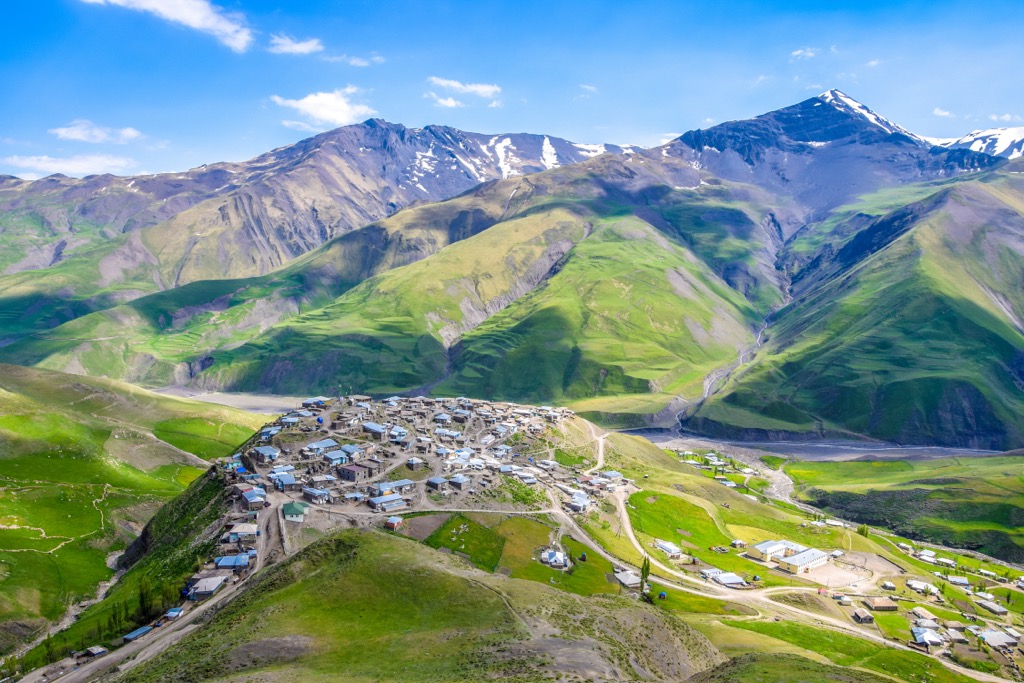
There are several versions of the origin of the name of Azerbaijan (Azerbaidjan or Azerbaidzhan). According to one of them, the name comes from the Persian words "Āzar" (fire) and "Pāyegān" (protector), which can be translated as ‘defender of the fire’ or ‘temple/country of fire’. This may be due to the fact that fire-worshippers lived here in the past and rightly so. Geographically, the Absheron Peninsula is rich in gas and oil, the gas seeps were considered divine and ethereal, thus attracting fire worshippers from all over the world, they built their temples here, some of them have survived till the modern day.
Azerbaijan has absorbed a variety of beliefs and traditions, layering the perennial age-old customs with the best new practices of its neighbours. Apart from that, Mother Nature has endowed this small country with a warm sea and majestic mountains with snow-capped peaks, unforgettable lakes and mighty waterfalls, virgin forests and alpine meadows, mud volcanoes and healing mineral springs.

The official name of the country is the Republic of Azerbaijan. The country gained independence in 1991. The territory is divided into 66 districts and 12 cities of republican significance. Several districts make up the autonomous republic of Nakhechivan (aka Nakhchivan). Some districts are considered disputed territories which are controlled by the Nagorno-Karabakh Republic (not internationally recognized at the moment), as well as Armenia (partially). The most popular regions among travellers are Gobustan, Absheron, Shemakhinsky, Gabala, Gheychaysky, Gubinsky, Shekinsky, and Gheyghyolsky.
The capital of the Republic of Azerbaijan is Baku. The area of the country is 86,600 sq.km.. The population is 10,152,829 people as of 2021.
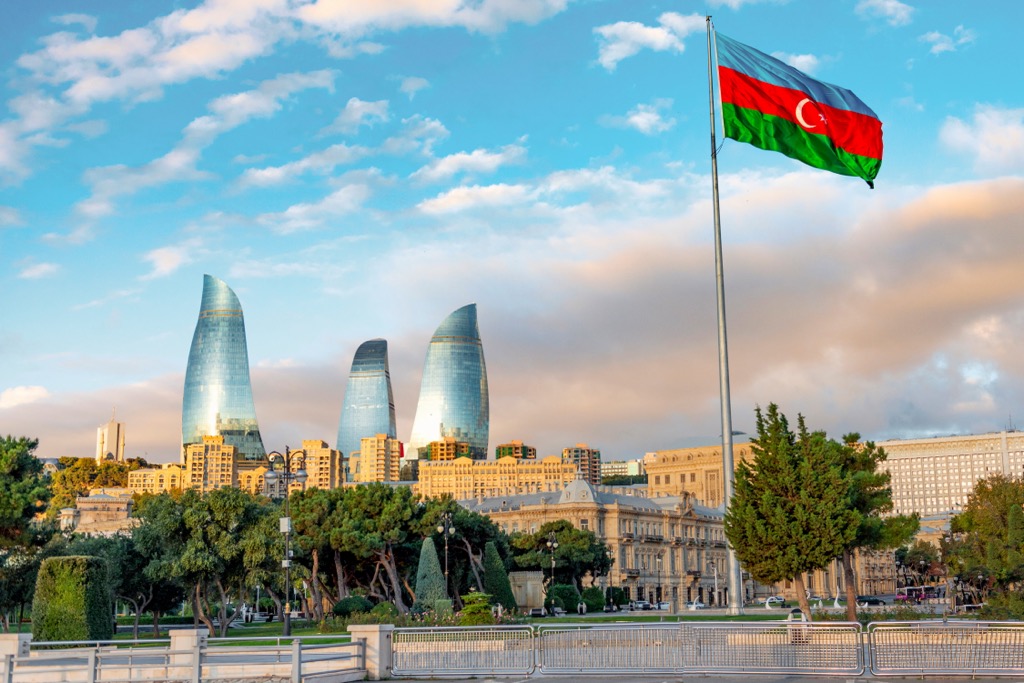
Located in the north-east of the Western Asia, Azerbaijan belongs to the Transcaucasian Region, its southeastern part. It neighbours Russia in the north, Georgia in the northwest, Armenia in the west, Turkey in the southwest, and Iran in the south. The eastern part of the country is washed by the Caspian Sea. The territory of Azerbaijan includes not only the mainland, but also many small islands of the Caspian Sea.
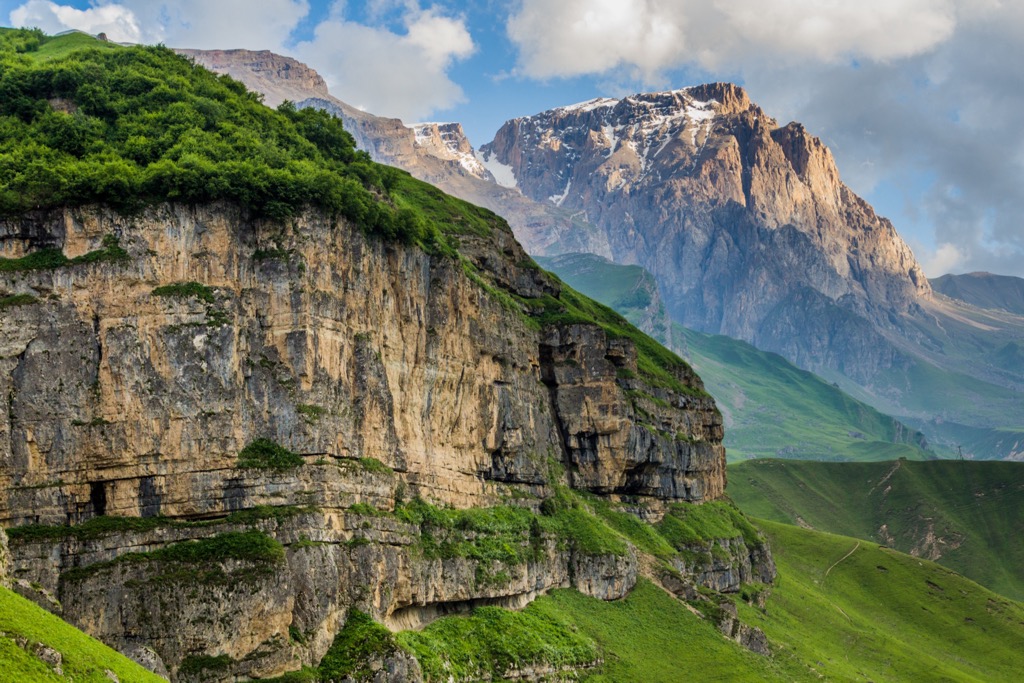
The variety of landscapes here is astounding! Azerbaijan can please the most fastidious traveller seeking for a tad of diversity. There are mountains, highlands, plateaus, plains and lowlands as well as rivers, lakes, waterfalls, seashores etc.
Almost half of the territory is occupied by mountains. There are 1503 named mountains. The whole country is dotted with mud volcanoes.
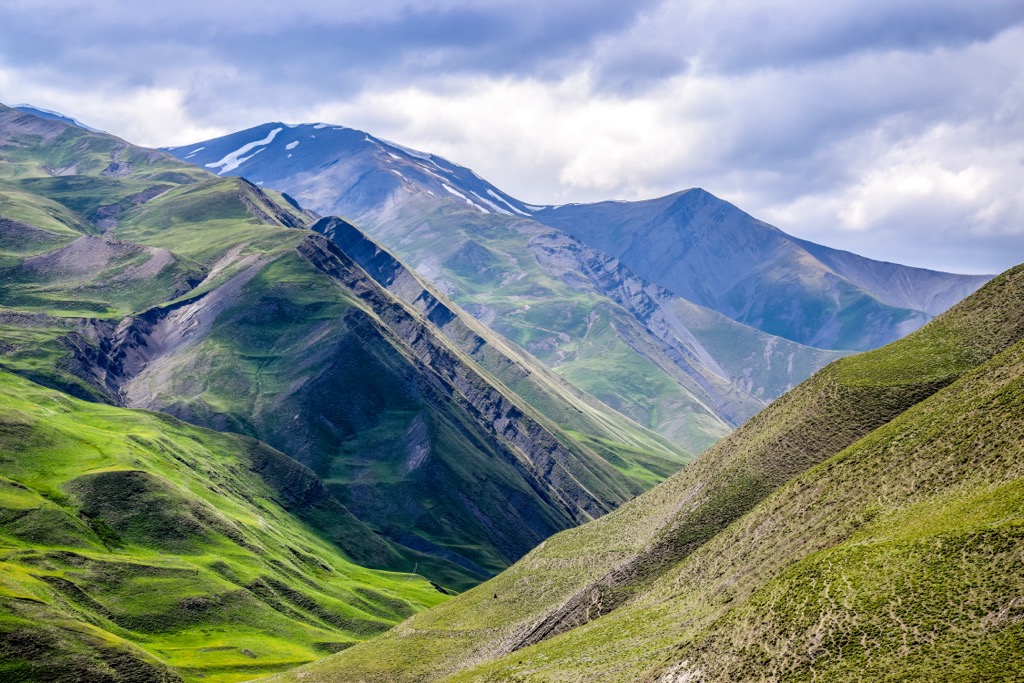
The highest point of the country is Mount Bazarduzu (4,466 m). It is located on the Main Caucasus Range, which is often called the Watershed Range. The northern part of the country is bordered by the Greater Caucasus Range, while in the southwestern part of Azerbaijan is the Lesser Caucasus Range.
The Eastern Caucasus, which stretches 500 km to the east from Mount Kazbek (5,054m) to the Caspian Sea, is characterised by large drops in altitude between the ridges and valleys, which in some places reach between 1,000 to 2,500 m. The rocks are mostly severely destroyed except for those massifs formed by solid rocks, and the cliffs are quite mobile.
In the southeast and middle part of the country, the fertile lowlands spread far. The valleys of almost all the rivers are narrow.

The mines and quarries of Azerbaijan contai many natural resources such as non-ferrous metals, iron ore, oil, gas, rock salt (halite), etc.
There are 1,250 rivers flowing into the Caspian Sea. The largest river, not only in the country but in the whole Caucasus, is the Kura River (1,515 km long). The second largest river in Azerbaijan is the Araks, a large tributary of the Kura River. The Mingachevir Reservoir, which is also called the Mingachevir Sea, was man-made to service the Mingachevir Hydroelectric Power Plant. The reservoir's filling began in 1953 and was completed in 1959.
In addition to many rivers, there are a large number of waterfalls in the country.
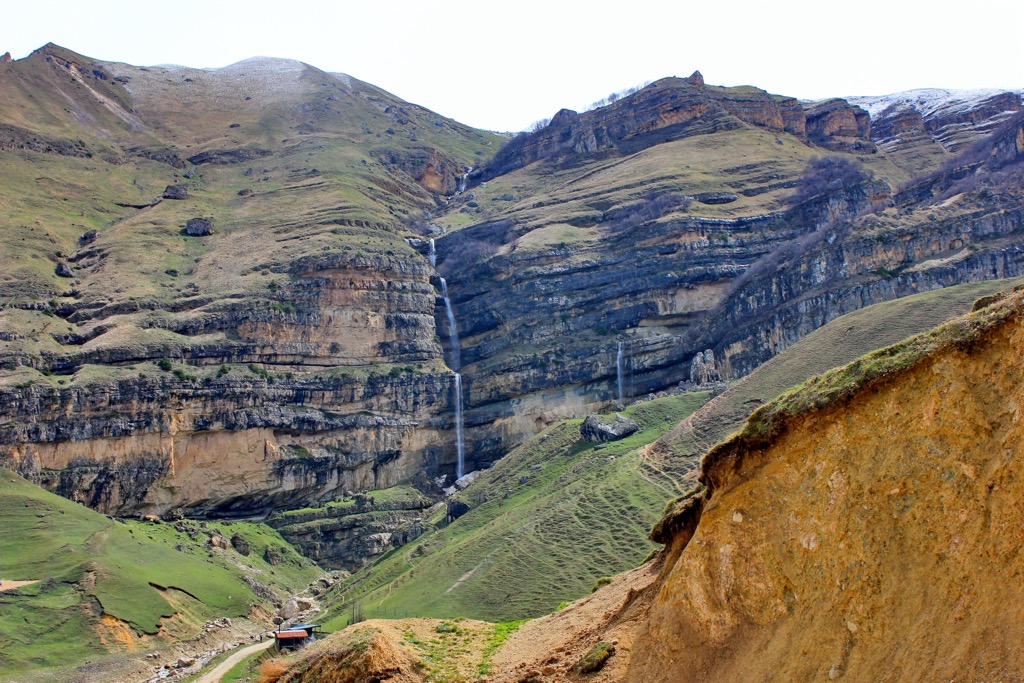
There are 250 lakes in the republic, too. The largest of them are Gadzhikabul Lake and Beyukshor Lake. The majority of lakes in Azerbaijan are of small size. The northeastern slope of the Murovdag Ridge is strewn with several picturesque lakes, including Geygel Lake. It is considered one of the most beautiful in the whole Caucasus.
There are more than 100 bogs and swamps in the republic, which are mostly located near rivers and on the plains.
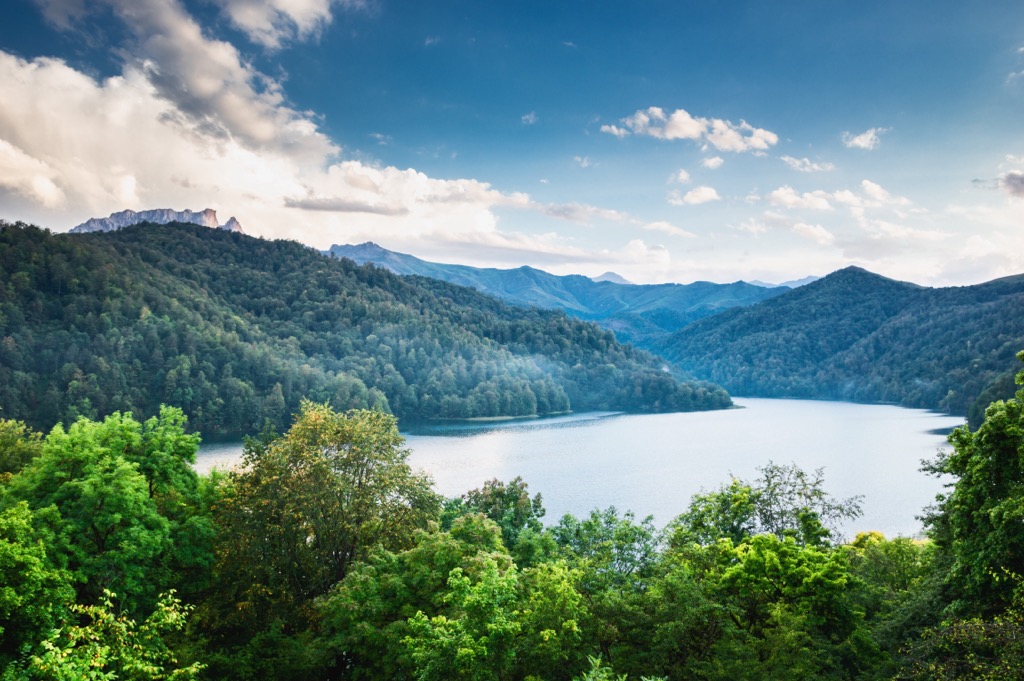
Azerbaijan is famous for its rich flora, especially compared to the other republics of the South Caucasus. There are over 4,500 plant species growing here, including rare and endangered species.
When passing through this mysterious country, one gets the impression of being in a fairy tale. The landscapes seem to be the lavish decorations for fantasy films settings, arranged according to the most bizarre plots. Here you can see forests with mighty trees, and deserts with xerophytes plants, which are adapted for life in the driest places, steppes, alpine meadows and subalpine woodlands.
The subtropical landscape can be found in the Hirkan National Park. Most of the plants growing here are endemics, which grow only in Azerbaijan. They are listed in the Red Book. In total there are about 240 endemic species in the country. Among them are local species of figs, frog grass, yellow swamp lily and others.
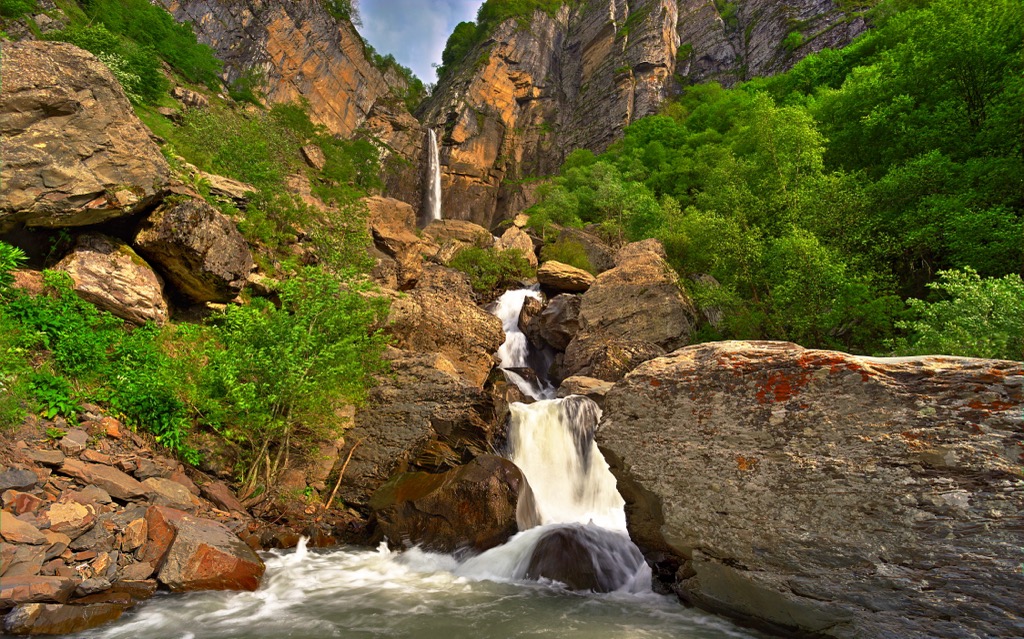
Xerophytes can be found in particularly hot and arid regions of Azerbaijan - Jebrail, Nakhichevan Autonomous Republic, Zangelan - as well as in the mountain plateaus of the Greater Caucasus. Here grows astragalus, frigana, acantha lemon, and lichens as well as pistachio and juniper trees.
along the rivers and in swampy areas, you can find reedbeds, water chestnut, salvinia, pondweed, and yellow marsh lily. Dry bogs are characterised by buttercup, mint, butterscotch, and sporewort.
The tops of the mountains are decorated with real alpine carpets made of quite low stunted plants, such as plantain (this humble plant is now in vogue among many nutritionists and is known by a now fashionable name psyllium), dandelion, caraway plant (Carum), lady’s mantle (Alchemilla), etc. And in the middle of the rocky terrain grows bellflower and sibbaldia. The plains of the foothills are sometimes overgrown with wormwood.
The forests here are gorgeous and amazingly varied: you can encounter riparian, broad-leaved (oak, chestnut, hornbeam, beech, etc.), mixed and, rarely, coniferous forests. Ancient forests are located mainly in the Talysh zone. Tugai forests, or riparian woodlands, and alder and wing-nut forests grow in wet lowlands. The northern slopes of the mountains are often covered by birches with curved trunks; these are the sad reminders of the avalanche's knock-off power. In the northwestern part of the country, on the Eldar plain, grows the relict Eldar pine. Relict species can be found in any region of Azerbaijan, i.e. Parrotia persica, chestnut oak, Lankaran acacia, Caucasian persimmon tree, etc..

Parrotia persica, which is also called the "iron tree", deserves a special mention.
It is called so because of the properties of its wood. The wood is incredibly dense, hard, and sinks in water. In terms of strength it can surpass even some metals. This tree grows very slowly, but is long-lived and can happily thrive for over 200 years. It can grow up to 30 metres tall. In ancient times, warriors made weapons from this wood (spears and stakes). Nowadays, it is used to make window frames, flooring boards, furniture, shuttles for weaving machines. By the way, a live ironwood fence looks very aesthetically pleasing, especially when this tree blooms. The tree is included in the Red Book. And the forests of Parrotia in Azerbaijan are a UNESCO World Heritage Site.
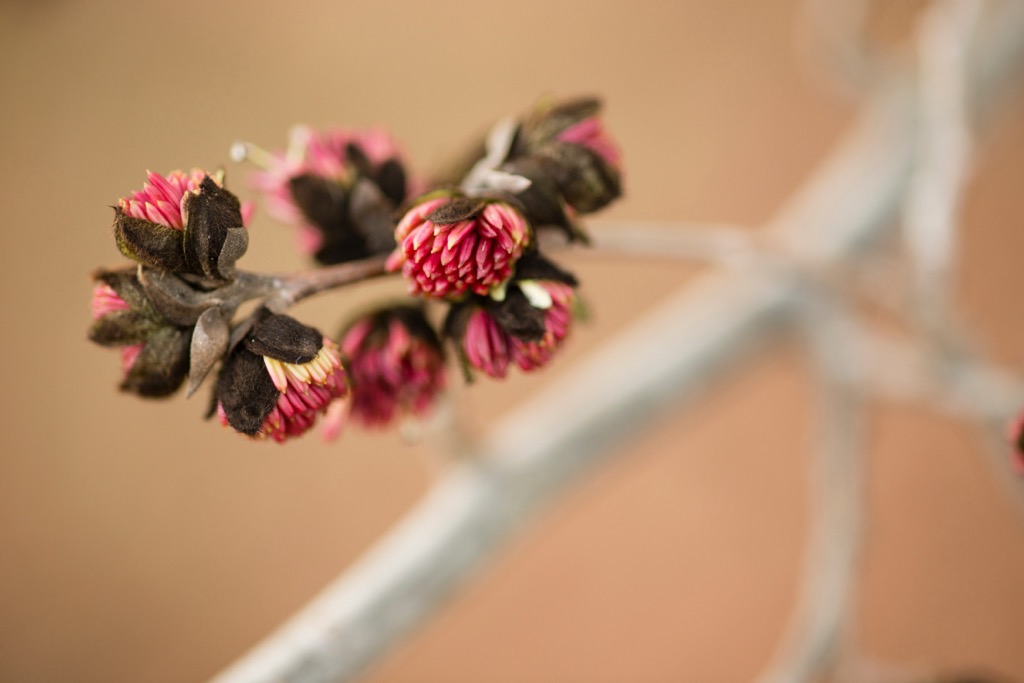
The animal world of Azerbaijan can also boast of its diversity. Despite the relatively small size of the country, there are a huge number of different species. One of the reasons for this is that the republic is home to almost all types of the Earth's climate. Local forests are home to deer, bear, fox, wolf, hare, wild boar, lynx, Pallas' cat and other animals.
However, some animals prefer not to show themselves to humans. Take the wild bezoar goat for example. It prefers not to demonstrate its face to people and runs away to its shelter at the slightest sign of danger. It can jump up to 3 metres in length. It is found in the mountains and rocky areas. The goat gets its name from the presence of bezoars - the lumps of undigested food in its stomach. Remember how Hermoine Granger claimed the bezoar stone to be a perfect cure for all poisons except for basilisk venom. In ancient times, healers and herbalists considered them a very useful medicine. This is evidenced by the translation of the word "bezoar" from Persian, which means antidote. It was also used as a talisman.
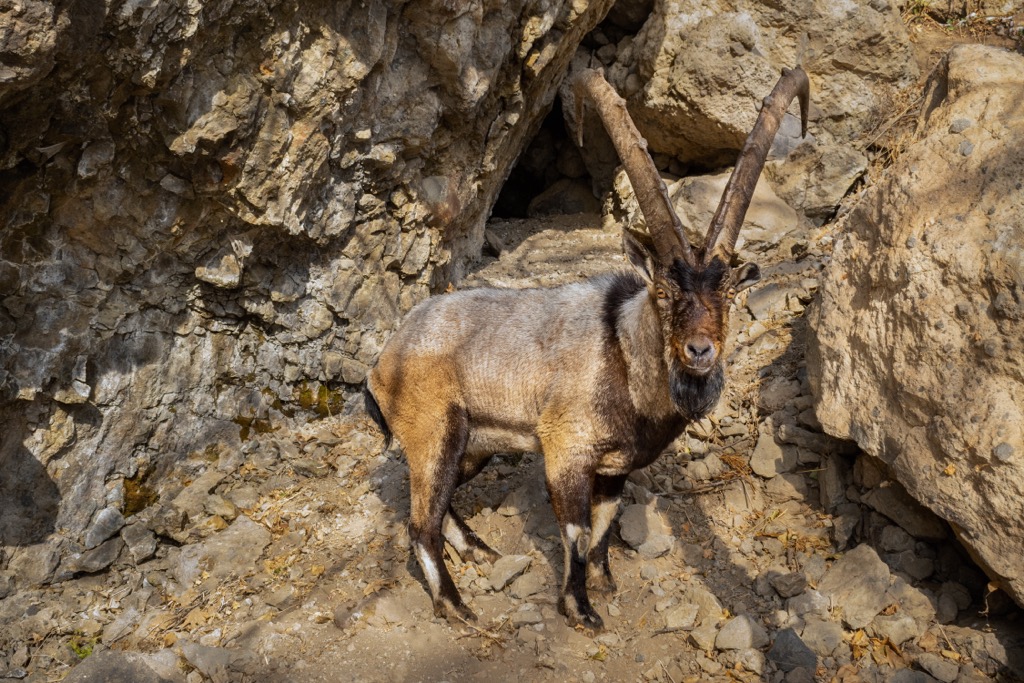
In the river valleys one may come across gazelle, Dagestan auroch, wild boar, roe deer, chamois, badger, and jackal. The plains and other arid zones are home to many reptiles, including lizards and poisonous snakes. Camels also live here.
The bays of the Caspian Sea are teeming with bird bazaars. There are partridges, pheasants and grouses. Many of them are migratory and can be seen only during their wintering period like pelicans, flamingos, cormorants, geese, ducks, herons, swans, etc.
Water bodies are inhabited by sturgeon, salmon, beluga, roach, lamprey, carp, starred sturgeon, catfish, pike, bream and others. You are allowed to catch only among the permitted 30 species of fish if you go fishing in the Caspian Sea and fresh waters of Azerbaijan. Some fish can be caught in reservoirs, others in the Kura River. Huge amounts of fish are raised in local fisheries and fish farms.
Azerbaijan is blessed with a really unique climate. Within this small country, there are 9 climatic zones out of 11 possible. The climate zones vary from mountainous to dry and humid subtropical. On the one hand, the climate is influenced by the mountainous terrain, on the other - by the warm Caspian Sea. Azerbaijan is characterised by fairly warm winters, hot dry summers and strong winds, especially in the fall.
At different times of the year, the weather in Azerbaijan will vary significantly, which should be taken into account when planning a trip. It is also important to know what part of the country you will spend your vacation in because it will be much cooler in the mountains with temperature minimum reaching -30°C (-22F), whereas flatter areas might be pretty scorching with temperature maximum up to +45°C (113F).
In winter on the same day, the temperature in the mountains can drop to -15°C (5F), but Baku will enjoy plenty of sunshine and a temperature of +10°C (50F), however, despite a warmer climate, Baku is subject to cold winds. The coldest months are January and February.
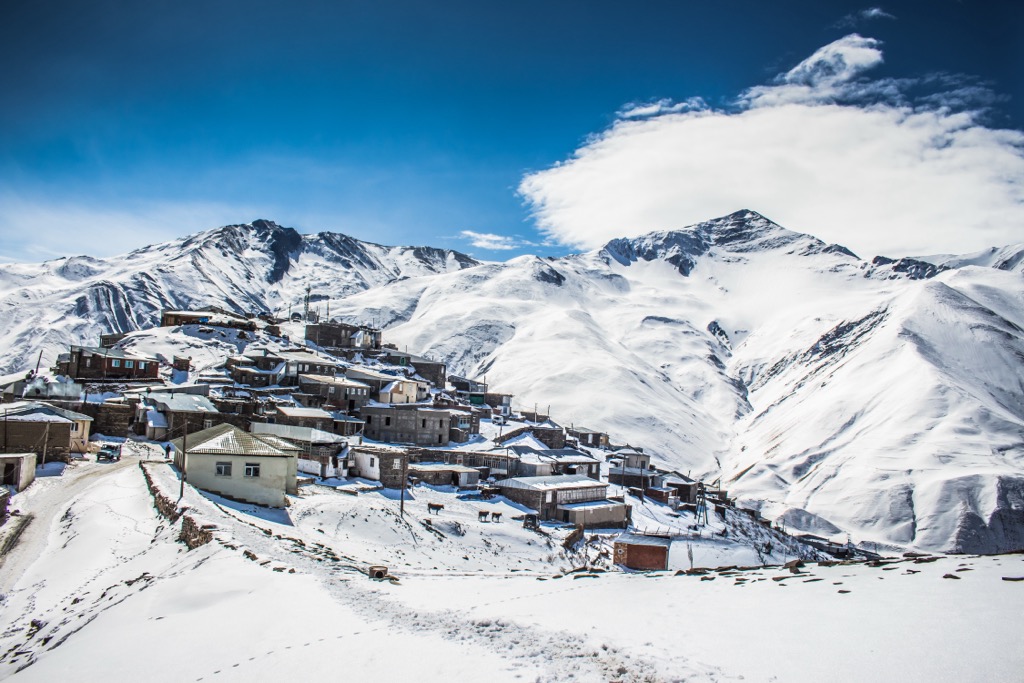
Spring begins in March. The weather is very sunny, but also windy and changeable. Yet, it is well worth visiting Azerbaijan at this time because everything is blooming. By mid-spring, all the valleys are in bright colours, while white caps of snow still sparkle on the mountains. Snow does not melt in the mountains until mid-April which means you can still enjoy some skiing there. May is one of the best months to visit the republic. Precipitation is unlikely. The average temperature is +22-24°C (72-75F). The sun is so hot at this time that it can be called the first month of summer. Don’t forget to bring a cream with a good SPF-factor to protect against the sun's rays.
Summer will show its hot-temper in all its glory in July when the temperature rises to +32 / +35°C (90-95 F). So July and August are not suitable for long excursions and exposure to the sun. But if you opt to enjoy some cool water in the pool or the sea, relax under a huge parasol or conquer mountain peaks, your trip will be truly unforgettable. The average temperature in the mountains in the hot season is +20 /+24°C (68-75F) which is very comfortable for recreation. Summer lasts longer on the plains, it is warm well into September or even October. Yet, the mountains are the first to experience the cooling breath of the autumn.
Autumn in Azerbaijan is a time of taking in mind-blowing diversity of colours. The golden time in the mountains begins in September. The weather is still quite warm and sunny. The bathing season continues until October. This is another month much beloved by travellers. Autumn is the best time to enjoy all types of recreation - active, beach, sightseeing, etc.

By the end of October, snow falls in the mountains. In November, it gets colder, it often rains, and the sky is overcast.
Azerbaijan has been massively investing into tourism and developing recreation facilities. There are ski resorts, recreation centres, spas and balneological resorts like Naftalan for example, where you can be treated to crude oil baths.
Summer is calling for hiking and trekking, mountaineering in the majestic mountains, or going horseback riding and joining ATV races.
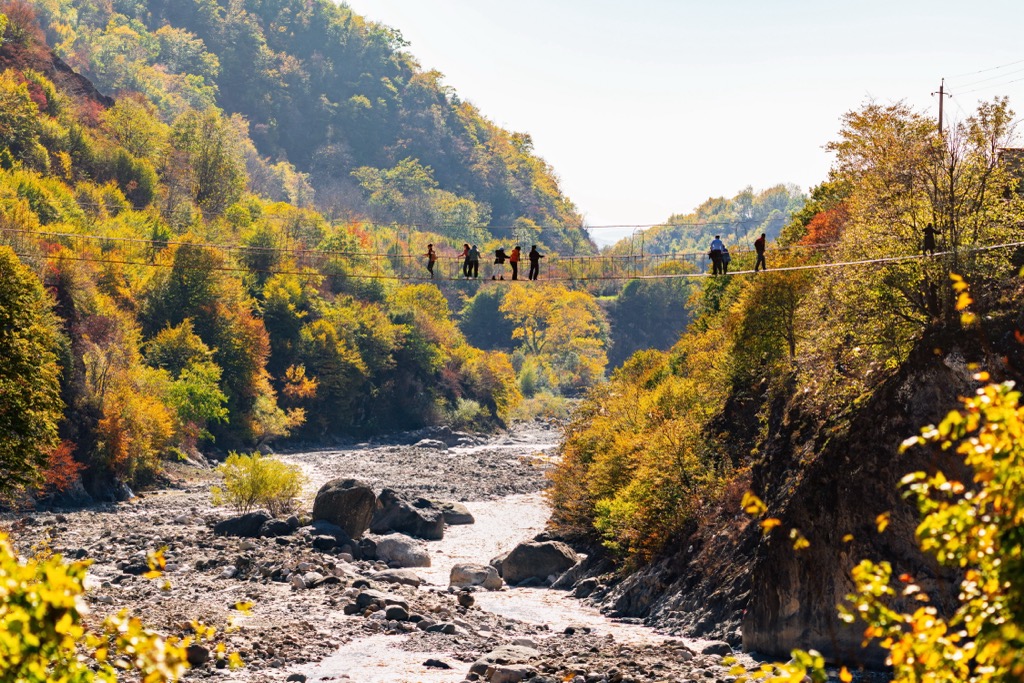
There are about 10 permanent mountain sports clubs in the republic which organise hikes on a regular basis. The closest places to Baku for hiking are Gobustan and Beshbarmag Mountain. Gobustan is a mountainous area located in the southeast of the Caucasus Mountains, approximately 60km from Baku. It is a protected area. The most popular routes for easy hiking are routes to the picturesque lakes Ambil and Garanohur.
As for some mountaineering experience, the path to conquer the Caucasus peaks begins from the village Hynalyg. Here one can hire a truck to get to the Shahdag National Park where base camps are situated and from there one can start climbing the most majestic mountains of Azerbaijan: Bazarduzu (4,466 m), Shahdag (4,243 m), Tufandag (4,191 m), Gizil Gaya (3,700 m), Zyafyar (4,301 m), Heydar Aliyev Peak (3,751 m) and others. Even though the route is not very strenuous, it requires good stamina and a high level of fitness to reach Heydar Aliyev and Gizil Gaya peaks where it is recommended to start further climbing. But going farther to Bazardüzü, Shahdag and Tufandag is very demanding and only highly experienced climbers can do that. It is possible to get to Zyafyar during the descent from Bazarduzu peak.
If you prefer ice climbing, go to the villages of Gusar and Laza. In winter, you can climb frozen waterfalls to your heart's content.
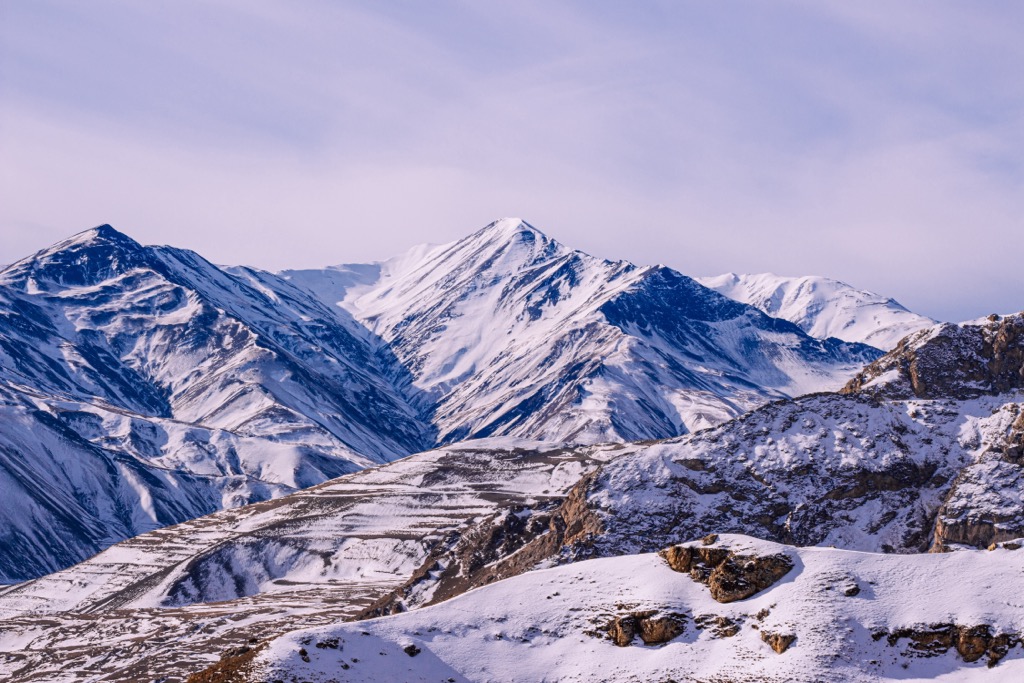
It is highly advisable to do the climbing only with the guides of one of the local mountain clubs. The most famous clubs in Azerbaijan are the Baku Alpine Club and the Gartal Club. One can also apply to the Mountaineering Federation of Azerbaijan.
Azerbaijan mountains are also great for lovers of downhill skiing and snowboarding. The top ski resort in Azerbaijan is Shahdag complex. There you can find entertainment at any time of year. It is located on the slopes of Shahdag Mountain, on the territory of Shahdag National Park. Another ski complex is situated on Mount Tufandag. Experienced skiers believe that the slopes at Tufandag are easier whereas the locals are said to prefer Shahdag more.
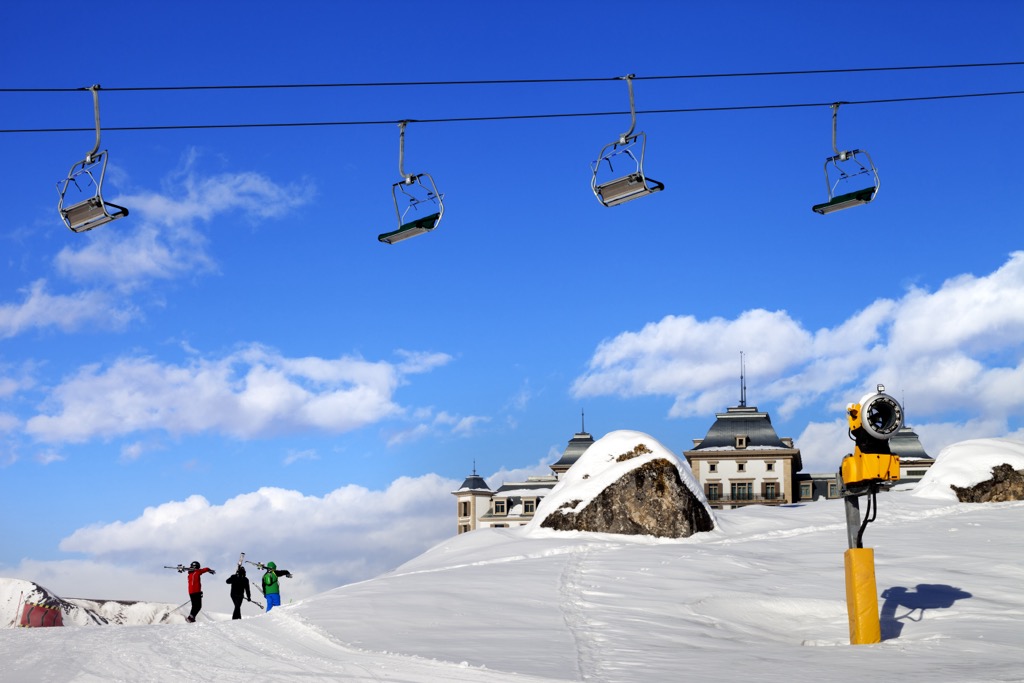
Cycling often tops the bucket lists of people coming to Baku. Riding around the city, you can see a large number of landmarks. Bicycles can be rented on Seaside Boulevard. Also, in Baku you can arrange a race at an indoor Baku Karting & Event Сenter which is the largest karting centre in the Caucasus.
There is a kitesurfing centre in Shurabad, which is number one in Azerbaijan. You can buy or rent a board, kite, and related accessories at the beach of Blue Planet Kayt.
Dreaming of diving to the bottom of the Caspian Sea? Dolphin Baku Club offers you the opportunity to dive on the Absheron Peninsula. The diving usually takes place from Pirallahi Island. However, you should be prepared for the fact that plankton in the sea can make it somewhat difficult to see the beautiful views.
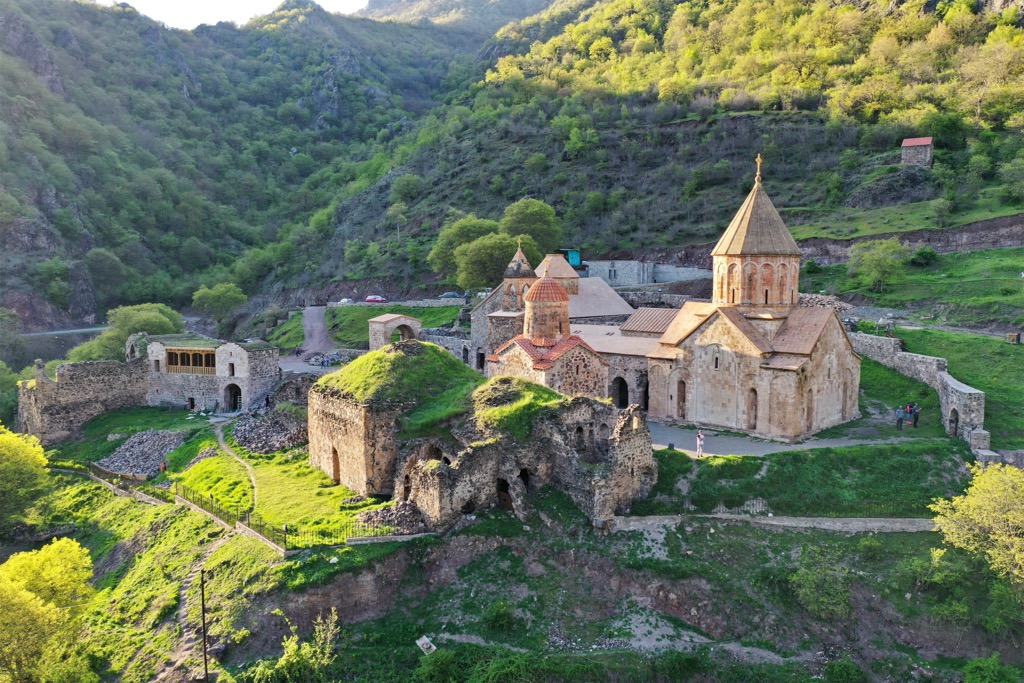
Azerbaijan hosts the mountains belonging to the Greater Caucasus in the north and the Lesser Caucasus in the west and southwest. Together with the Talysh Mountains, they cover the Kura-Araz lowland from the north, west and southeast.
There are two mountain ranges in the southeastern part of the Greater Caucasus: the Main or Watershed Range with Bazarduzu Peak, and the Lateral Range with Shahdag Peak.
The Lesser Caucasus encompasses the southwestern and western parts of the country, has relatively low elevations and is a mountainous area with a complex structure. The main mountain ranges are Murovdag, Shahdag and Zangezur. The Karabakh Plateau, starting from the south of Murovdag to the Araks River, is located on the arc-shaped cones of extinct volcanoes and lava of the fourth period.
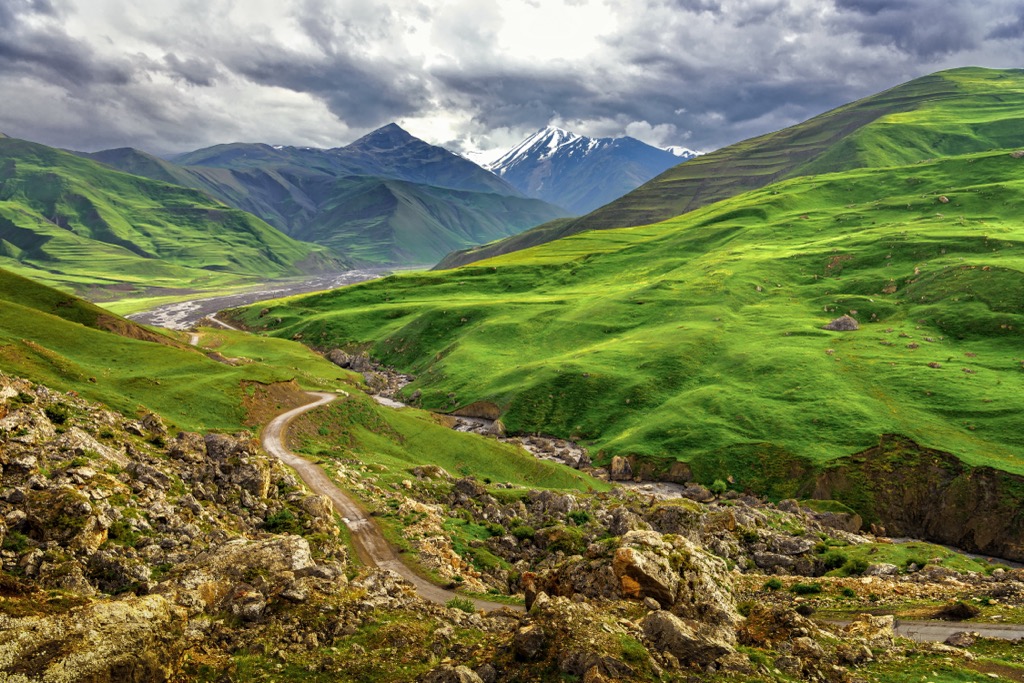
The highest mountain of the republic Bazarduzu, also spelt as Bazardyuzyu, is located on the border of Azerbaijan and Dagestan, Russia. Bazarduzu lies north of the Caucasus Main, the border between Europe and Asia, which makes Bazarduzu a purely European summit.
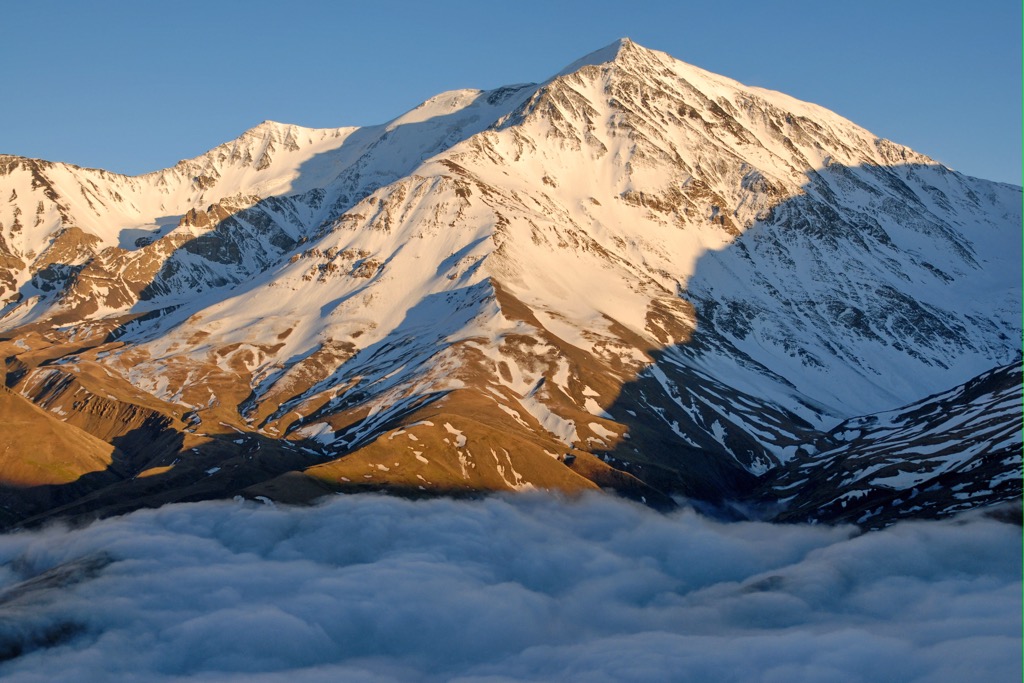
The name Bazarduzu means "market square" in Azerbaijani and Turkic languages. This name appeared for a reason. In ancient times, large fairs used to take place every year in the Shakhnabad Valley, east of Bazarduzu. These fairs attracted traders from all over the ancient realm, you could meet here the representatives of the peoples of the Eastern Caucasus, the Georgians, the Persians, the Arabs, the Armenians, the Jews, the Kumyks, the Tsakhurians, the Indians, etc.
The local population however, was not that positive when naming Bazarduzu. In the village of Kurush - the highest mountainous aul in Europe - Bazarduzu is more known as Kichensuv, which means "Mountain of Fear", or Kichevnedag, which is translated from Lezgin as "Mountain of Terror" and also Tikisar - "High Head". The latter needs no explanation, but the first two names suggest that they are associated with the legends and myths enveloping the peak.
The northern and western parts of the peak (in the direction of Dagestan) are ice walls, the southern and eastern parts (in the direction of Azerbaijan) have quite steep scree walls which are black. The rocks of the mountain are composed of shale porphyries. Large parts of the mountain are heavily weathered with rubble and scree slopes. On the summit itself, there is an ice dome, so using crampons to increase anti-slip is essential. At the beginning of the 20th century there were eight small glaciers up to one kilometre from the summit area, now most of them have melted away. But the summit ice fields are still the biggest glaciers of the Eastern Caucasus.
Vegetation is sparse and found only in the valleys at the foot of the mountain where there are vast alpine and subalpine meadows. On the barren mountain sides live East Caucasian ibex (Capra cylindricornis) and chamois (Rupicapra rupicapra).
The Mount Bazarduzu is extraordinarily independent, the prominence is about 2,454m. In the same Caucasus Range it is second only to Elbrus whose prominence is 4,471m.
The southern side of the mountain belongs to Sahdag Milli Park, the largest National Park of Azerbaijan. Please bear in mind that if you want to climb Bazarduzu from Azerbaijan, there are three (3) prerequisites:
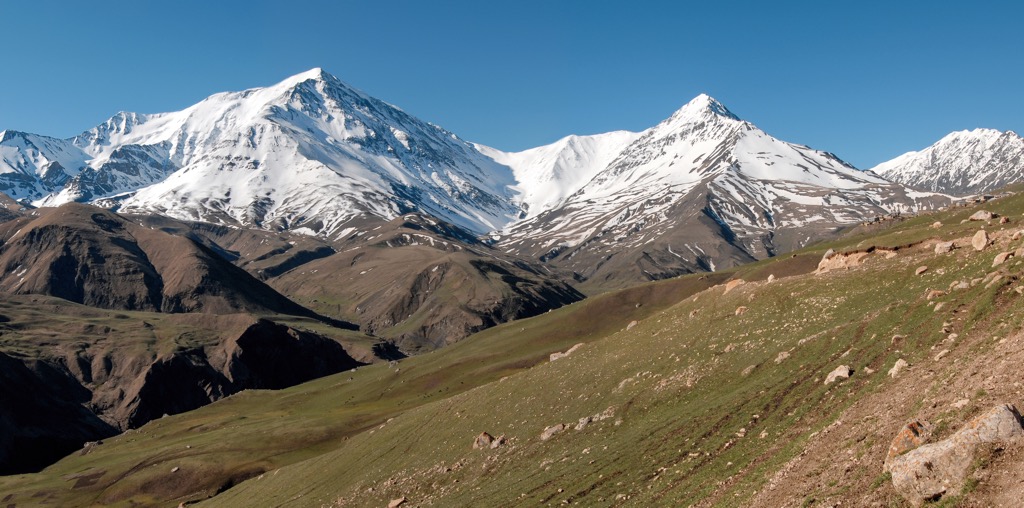
If you are climbing Bazarduzu from the Russian side, only a border zone permit from FSB is needed, it can be obtained in the FSB regional department in Makhachkala (Dagestan), apply 3 months in advance.
Shahdag (4,243m) is truly one of the most extraordinary mountains not only in Azerbaijan, but also in the whole Caucasus. The etymology of the name derives from the Persian word "Shah" - "king", and the Turkic word "dag" - "mountain", that is why it is sometimes called Tzar Mountian. Shahdag is the peak of the Lateral Range. Shahdag is the most visited mountain for winter recreation.
To the west of Shahdag are two blue lakes at an altitude close to 3,500m. From time to time there are strong floods. At an altitude of about2,000m one can find Caucasian and bezoar goats, chamois, blackbirds and lizards.
Frequent hurricanes and storms became the reason for the interesting name of this peak. Tufandag means "hurricane", and "dag", as it has already become known a few paragraphs above, means "mountain". Tufandag (4,206m) is located at the junction of Guba, Gusar and Gabala districts. Not far from the mountain there is a high-mountain village of Khynalyg, where representatives of one of the most ancient peoples of the Caucasus - the Khynalygians live. That is why this village annually becomes the place of visit for a huge number of tourists.
The uniqueness of local nature and the abundance of mountain rivers and lakes served as a good incentive to build a ski resort and a cable car here. The cable car takes visitors to different levels, and the highest point reaches about 2,000m a.s.l. You can enjoy the views of Tufandag and Bazarduzu from the cable car station and be as inspired as the great Russian poet and writer Mikhail Yurievich Lermontov, who wrote much about the Caucasus.
Besh Barmag Mountain (Azerbaijani: Beş Barmaq) is modest in size, just 382m a.s.l. but it looks like a rocky crown rising above a ridge overgrown with grass. There is a mosque at its foot.
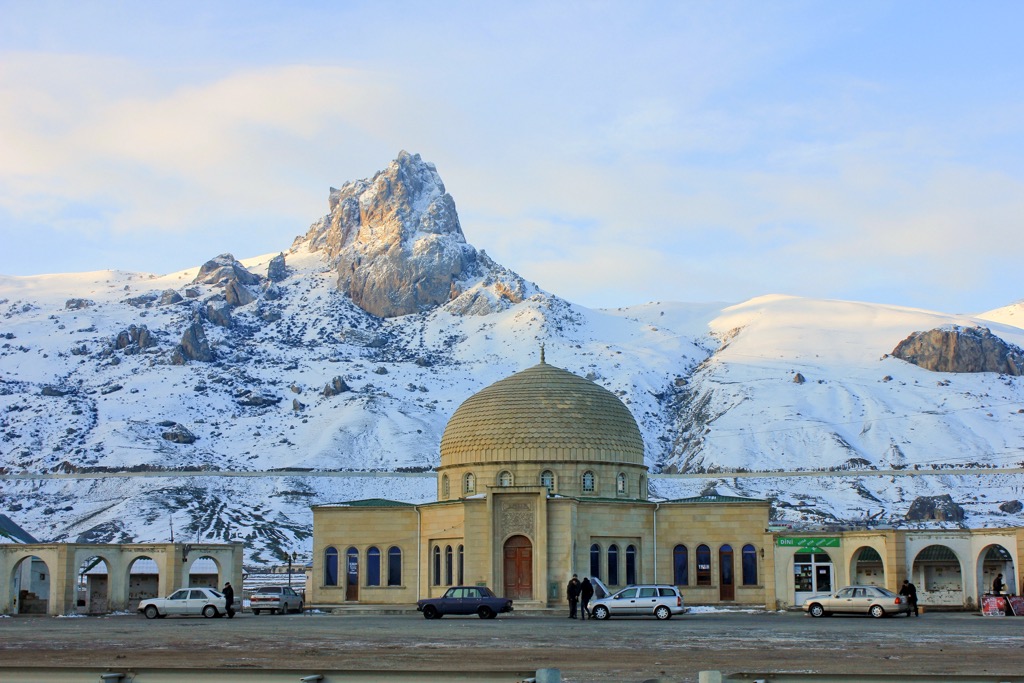
Beshbarmag is literally translated as Five Fingers. It is located in the Siazan District of Azerbaijan, not far from the Caspian Sea. Beshbarmag has always been a popular pilgrimage site. According to a legend, a person with pure thoughts who reaches the prayer house at the top of the mountain will have his cherished wish come true. There are also usually many women here who wish to become pregnant. On the mountain, scientists conduct their observations of migratory birds, as it is one of the key points of their route.

Once in the Khyzy Mountains, you feel as if you are visiting Mars. This is one of the most unusual places in the country. Cosmic landscapes shimmer in red, orange, pink, yellow, and beige hues. According to one version, such amazing shades of the mountains are due to underground waters affecting the degree of oxidation of iron rocks which the mountains are composed of.
After visiting the colored mountains of Khyza, you will understand why the British travel writer Mark Elliott called them "lollipop mountains”. By the way, Mark Elliott is the author of a popular guidebook to Azerbaijan.
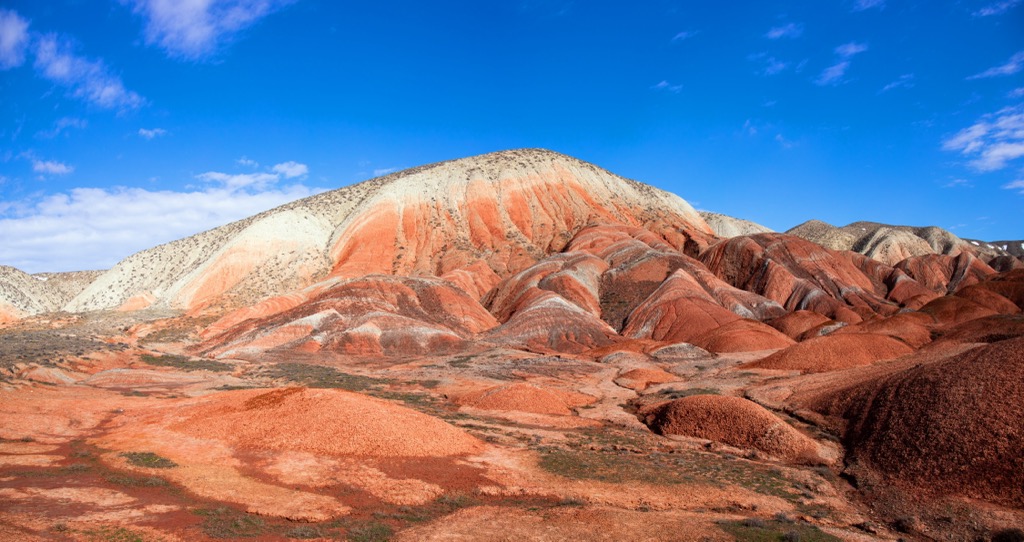
This place was once a staging ground on the Great Silk Road due to which it has a rich history and interesting culture. In Khyzy, you can visit the house-museum of the founder of Azerbaijani drama - Mirza Fatali Akhundov, ancient fortresses and places of power. There is also a reservoir Jeyranbatan as well as Lake Masazir (Masazirgol) with water of pink colour. The water in the lake is highly saturated with salt, for which it is sometimes called the Dead Sea of Azerbaijan.
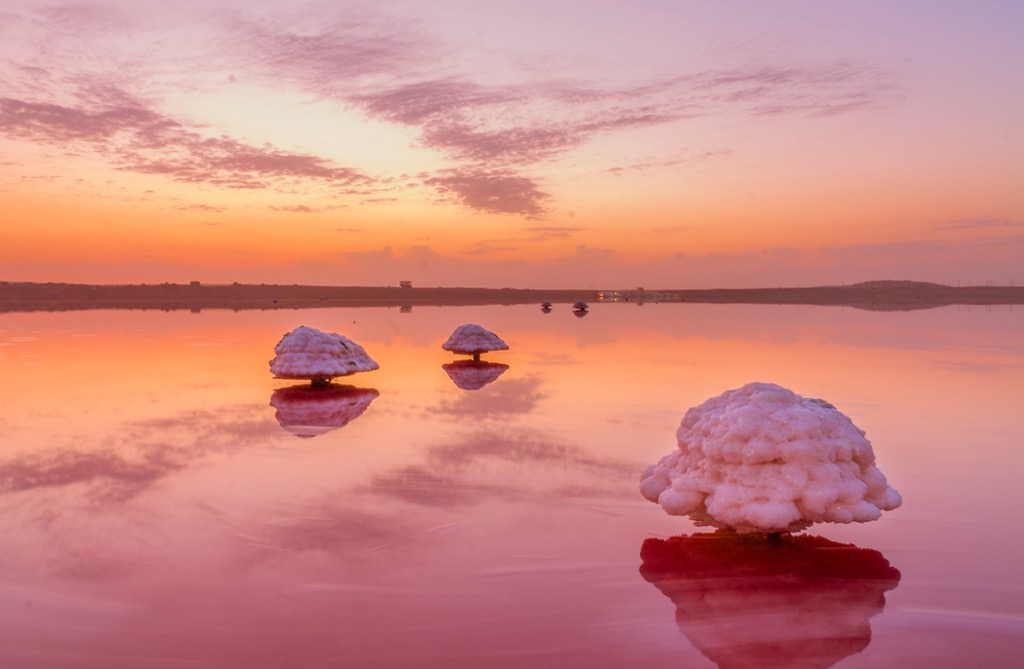
Unlike the Caucasus Mountains, the Talysh Mountains are not so high, composed of flaky and volcanogenic strata with intrusions of basic rocks. They are about 100km long. The highest point is Kamarkukh Mountain (2,477m). The summit of Kamarkukh, as well as Joni and Shindan, are considered extinct volcanoes.

The Lesser Caucasus and the Talysh Mountains serve as a connecting link between the Pontic Mountains in northern Asia Minor and the Elburz (Alborz, Albourz, Alburz) Range, a marginal mountain range in the northern Iranian Plateau.
Administratively the Talysh Mountains are located in the districts of Astara, Lankaran, Lerik, Masalli, Yardimli and Jalilabad in Azerbaijan, as well as in the districts of Namino, Astara, Fumansk, Masalli, Kolur and Masuli in Iran.
Near Lenkoran town, there are the Haftonin and Khavzovin hot mineral springs, near Masalla there are the Arkevan hot mineral springs, near Astara there are outcrops of thermal waters to the surface.
The Talysh Mountains are ideal for hiking and weekend hiking. It is possible to travel not only on foot but also by car here. You can drive along the Lankaran-Lerik highway and admire the scenery from the window, making stops wherever you wish. The highway runs on the slopes of the mountains. Another popular car route is Masalli - Yardimli - Arvana, where visitors can enjoy a burning pond, a waterfall and thermal springs. A convenient base for travelling to the Talysh Mountains is the pretty town of Lenkoran. There are many hotels and guest houses in the vicinity of the mountains themselves.
Dreaming of taking a healing mud bath? It is easy to do so in Azerbaijan which is famous for mud volcanoes. There are more than 300 of them, which is almost half of all mud volcanoes in the world.
When mentioning a volcano, we usually picture in our imagination a full or truncated cone chopped off at the crater. Mud volcanoes can be quite different from these classic volcanic forms though.
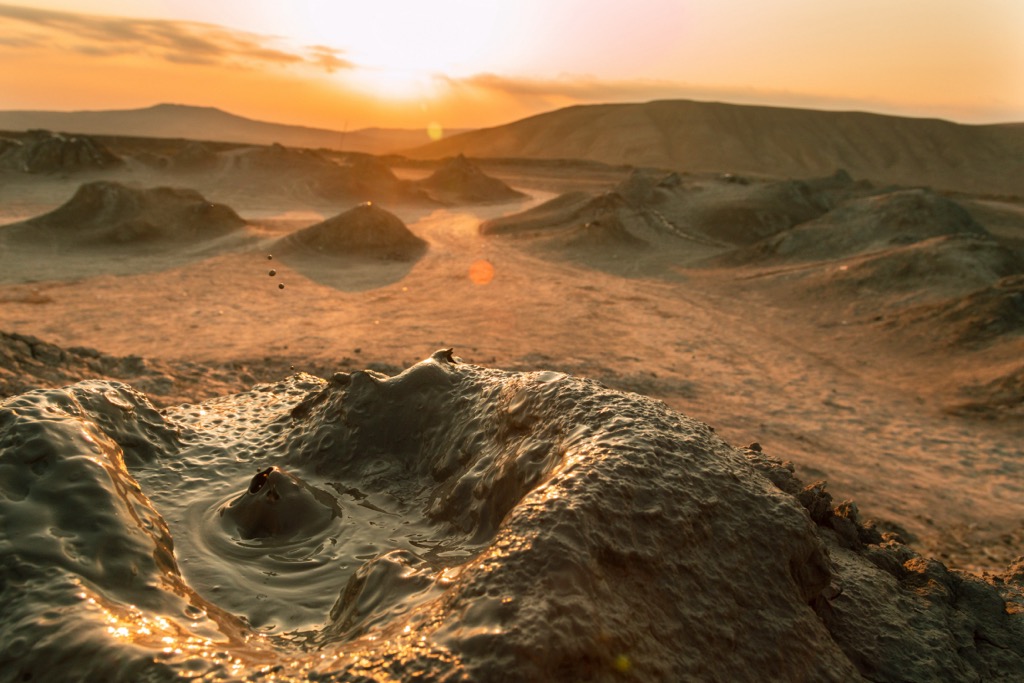
They may represent a vast volcanic field with many craters or with towering hills. The eruptions of such volcanoes may also differ from the occasional one-time burst to constant bubbling or gurgling of the mud on the surface of the crater.
The landscape around mud volcanoes is quite unfamiliar to the eye. Stretching for kilometres is a vast barren land of grey shades, covered with cracks, rare flecks of grass and small lakes formed in the calderas. Mud cones or hemispheres rise here and there from time to time.
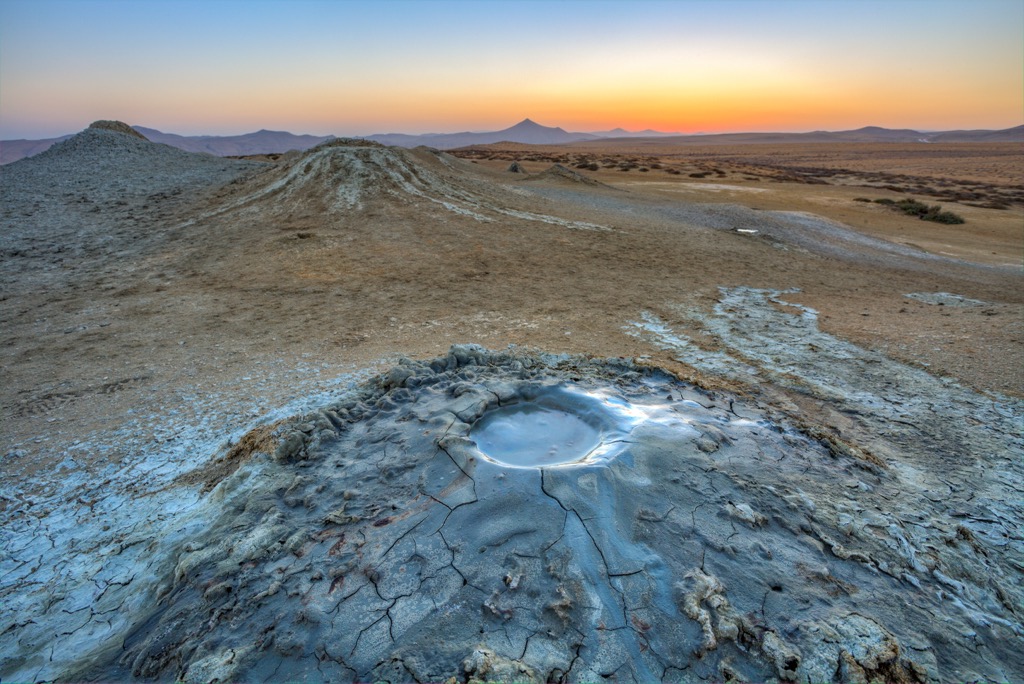
Mud volcanoes are called differently by the locals, viz. bozdag which translates as a grey mountain, or yanardag or flaming mountain, or gainacha which means boiling water.
Among the volcanoes of Azerbaijan there are underwater (buried), coastal, island, as well as mud-pumping volcanoes.
The composition of volcanic mud, or "breccia" in scientific jargon, tells scientists what is under the ground. A Volcanology R&D Institute is engaged in the study of volcanoes in Azerbaijan. Everyone knows about the usefulness of volcano mud for curing various diseases. In recent years, balneological resorts have been gaining popularity as more and more procedures with volcanic breccia for rejuvenation of the body appear on the beauty market. In half an hour of treatment, the mud will whiten the skin, straighten fine wrinkles, and nourish the skin with its nutrients.
Mud volcano reserves were created to ensure the safety of people during volcanic eruptions, as well as to preserve the pristine nature in the volcanic areas. In 2009, the volcanoes in the Mud Volcano Valley in Gobustan were included in the list of 28 finalists of the "Seven Wonders of the World" competition.
The most popular mud volcanoes are Bozdag Volcano, Guzdeg, Goturdag (in Gobustan), Bahar, Hamamdag and others.
Goturdag belongs to the mud-pressing volcanoes; Goturdag has been pressing semi-dry mud continuously to the surface for about 100 years.
A visit to the coastal volcanoes Bahar and Hamamdag will feature bathing in the sea and taking mud baths.

Yanardag is a place located a 30-minute drive from Baku. On a 5-metre section of the slope, there burns the ‘eternal flame’ of natural origin. This phenomenon has been observed here since the 1950s.
The fire looks especially spectacular after sunset. By the way, back in the 13th century Marco Polo wrote about multiple outbursts of natural gas on the Absheron Peninsula with subsequent combustion.
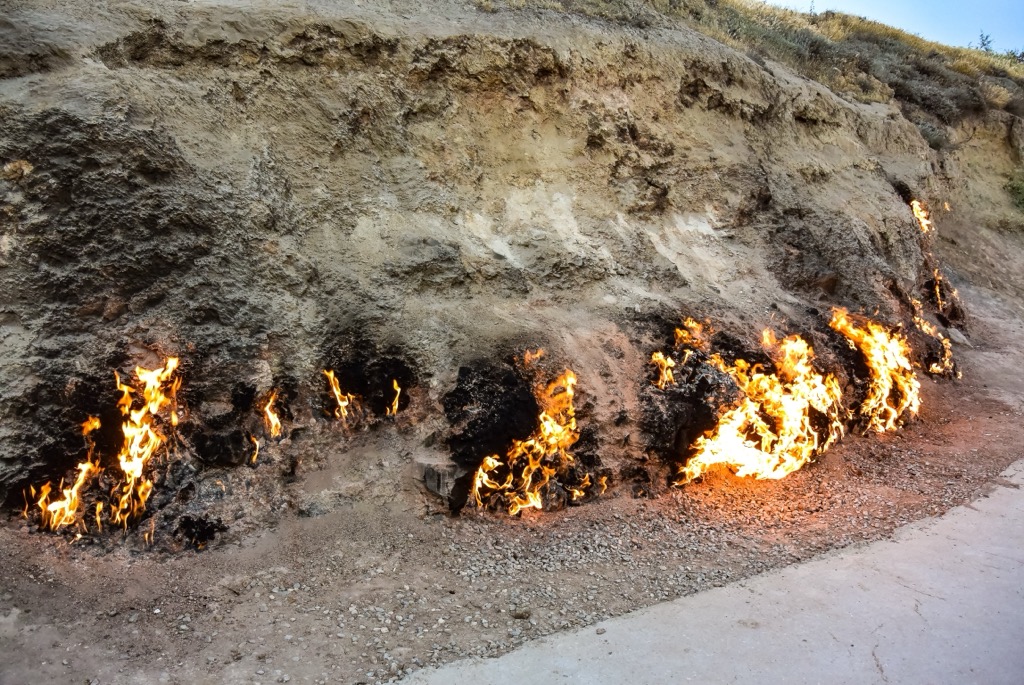
Most of the natural riches of the republic are part of the Azerbaijani national parks and reserves. Each state-protected area has its own peculiarities.
For example, the Girkan (aka Hirkan) State Reserve was established to preserve the population of Persian leopards. The Shirvan National Park protects gazelles. The Gizilagaj and Absheron national parks are home to wintering flocks of pink flamingos. The Turianchay Reserve is made to protect the Eldar pine. The Goygol Reserve is responsible for the preservation of the high-mountain Goygol Lake and the surrounding natural complex.
The Shahdag National Park is the largest in Azerbaijan. Its dense forests are home to all kinds of fauna and flora typical of the Caucasus Mountains.
Of the 12 nature conservation areas, the most important are Gobustan, Geygyol, Shirvan, Kyzylagaj and Zakatala sanctuaries. There are also 16 nature game reserves in the country.
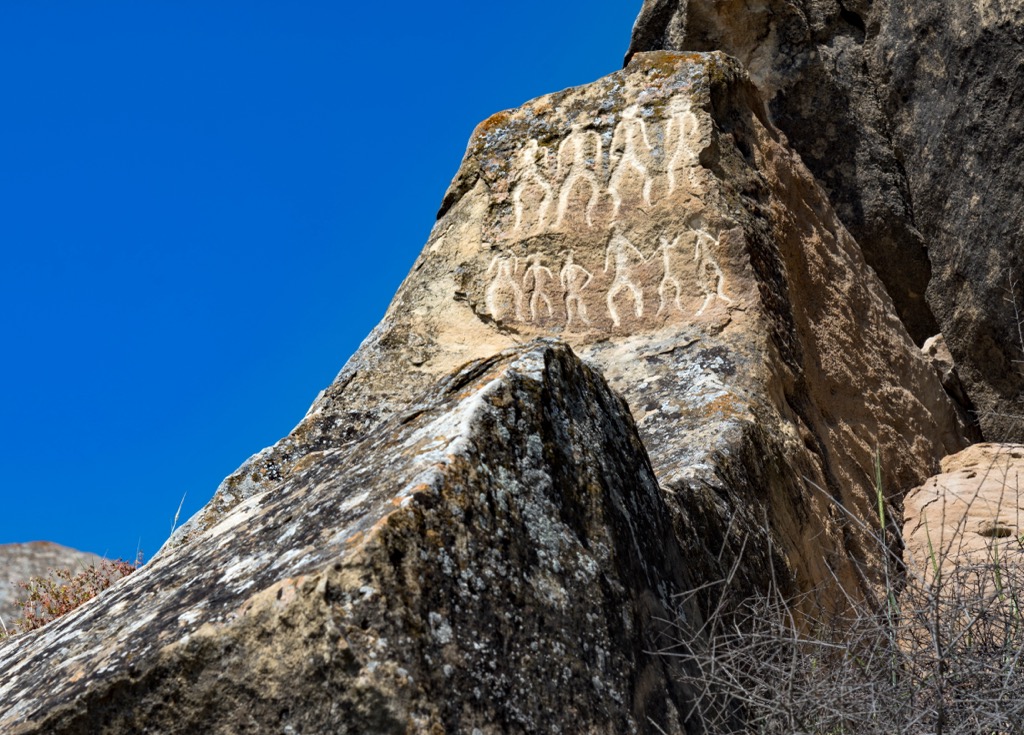
The most beautiful lakes of Azerbaijan are located in the west of the country, in Goygol district, in the Goygol National Park. The upper part of the mountain Kyapyaz was destroyed in the 12th century by an earthquake. As a result, the river Agsu was blocked with huge boulders. This is where 17 lakes were formed. The largest lake is called Goygol. Hiring a guide, you can ask him to show you all the lakes available to travellers and tourists. Some of them are quite small and are located close to each other. So you can visit four or five lakes in one day.
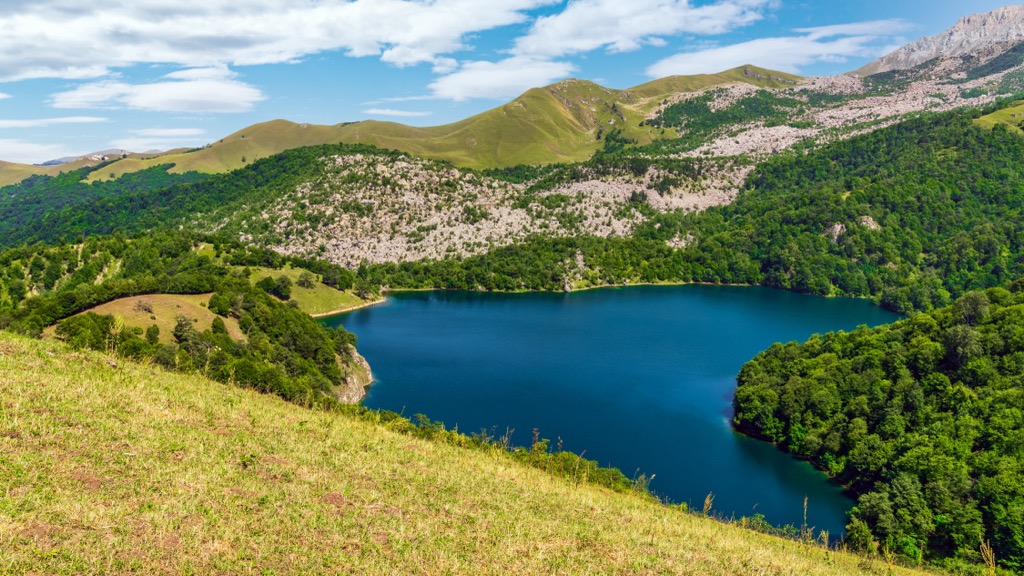
The Shabran forest in the north of the country is home to a small but very picturesque lake Ambil. You won’t find it on the map though, it is hidden 25 km northeast from Zeyva village at an altitude of 935m a.s.l. The lake's name can be translated from Arabic as "lake that belongs to the community" (in Arabic "am" means community, people, "bil" in Tatar means marsh, and most of the population of Zeyva village are Tatars). The lake is hard to reach, but the trouble is worth it. You can drive to Zeyva, leave the car there, and walk 6 km or so (it usually takes an hour) to the lake. Bring the tents and sleeping bags because it is allowed to camp around the lake.
Lake Garanohur is located at 1,540m a.s.l. The route to it takes about two hours from the entrance to Shahdag National Park. After leaving the cars in Talistan village, move up the slopes. Surrounded by dense virgin forest, the lake also has many comfortable places to rest.
Another mountain lake is Batabat, located at 2,113m a.s.l. It is located in the Nakhchivan Autonomous Republic, the westernmost point of the country. One can get here by plane from Baku. In the centre of the lake there is a floating peat island. The lake shores are framed by alpine meadows. Ilandag Mountain (2,415m) is also located here. The name in translation means "Snake Mountain". However, there are no snakes on the mountain. According to a legend, it was to its foot that Noah's ark moored here in ancient times.

There are a gazillion waterfalls in Azerbaijan. Some are far and remote, while others can be reached by car and you can have a perfect lunch break while enjoying the view of water streams falling from a height. The most popular of the latter category is the cascading waterfall of the Seven Beauties in Gabala. The highest waterfall in Azerbaijan (96 m) is the Mujug. You can reach it from the village of Laza (in Gabala). By the way, there are two settlements with the name of Lazah in the republic: one in the north (near Shahdag), the other in the west (in Gabala). Near the village of Lazah (near Gabala) there is another cascading waterfall. In winter, climbers hold competitions on the frozen waterfall.
The most popular waterfalls also include: Afurja, Takdam, Ram-rama, Galabin, Abdal Cascade, Katehchai, Pazmari, and Mamyrly.

There are more than 1,000 mineral springs both with thermal and cool waters with different compositions and healing properties, which improve the health. The most famous are Istisu, Badamly and Sirab.
Most mineral springs in Azerbaijan are located on the territory of Nakhechivan Autonomous Region. They appeared about 400 million years ago. There are about 250 mineral springs in Nakhechivan, which accounts for 60% of all springs in Azerbaijan. The most popular mineral waters are Istisu, Badamly, Vayhir, Sirab, Darydag, Gulustan and Narzan. Most of the mineral springs are located near the following rivers: Shargi Aparchai, Nakhijevan Chai, Alinjachai, Gilanchai, Garadere and Ailis. It has been determined that there are 6 types, 16 classes and 33 kinds of mineral waters in Nakhechivan. 98% of mineral waters of Nakhechivan belong to the category of hydrocarbonated waters. The temperature of most of the waters varies from 8°C to 22°C (46-71F). Higher temperatures are found in such springs as Sirab and Darydag, where the temperature can reach 50°C (122F) and higher.
Another place to go to get some health treatment is Naftalan, a unique balneological resort located in the western part of Azerbaijan, 360 km east of Baku and 48 km from the second largest city of the country - Ganja. It is famous for its crude oil treatment.
There are no beaches in the capital of the country - Baku, since it is a huge port. But you can rent a yacht at the yacht club and arrange a boat trip. From 15 and up to 70km away from Baku there are several both free and paid beaches. The whole coast there is sandy, beaches provide plenty of facilities such as sunbeds, cafes and even water parks. Should you wish to have some flopout holiday on a beach, go to the nearby Absheron peninsula which is practically one big beach strip along its entire coast. There is also one of the key attractions of the country - the temple of fire Atezhgakh.

Locals prefer the beaches on the northern side of the peninsula. The best of them are located in Nardaran and Bilgah. Nardaran has two popular recreation areas where in addition to beaches there are swimming pools, bars and restaurants.

Baku (the stress is on the second syllable) is not only the capital of Azerbaijan, but also the largest city in the Caucasus and the largest port in the entire Caspian Sea.
In the olden times, travellers entered the city through the majestically towering gates above the road. The gates are still standing these days. Baku offers a bizarre mix of the curved streets of the ancient city neighbouring side by side with modern buildings such as the Heydar Aliyev Cultural Centre designed by a famous architect Zaha Hadid in 2007, the Flame Towers and others.

The oldest, historical part of Baku is called Icheri-Sheher, which translates as ‘a city behind the wall’ or ‘inner city’ and is the heart of the city. Officially, these old quarters are part of the historical and architectural reserve, but you can get acquainted with them for free.
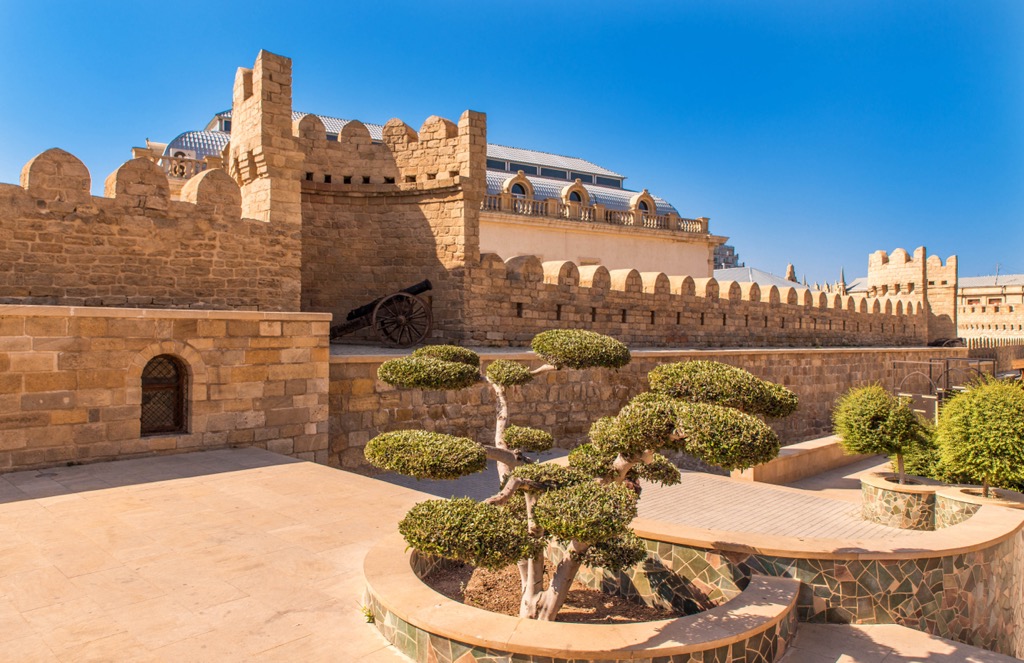
You can take a leisurely stroll through the Philharmonic Fountain Park, which is located not far from Icheri-Sheher.

The Friday Mosque, built in the 12th century, is one of Baku's noteworthy landmarks. Next to it is the Bazaar Square, another historical spot. This place was discovered by accident during the works on the improvement of the city.
If you happen to be lost in the city, look up and find the Maiden's Tower. This wonderful work of ancient architects rises 30 metres over the ground and can be easily seen from almost anywhere in the old part of the city. The Maiden’s Tower will not let you get lost in the capital.
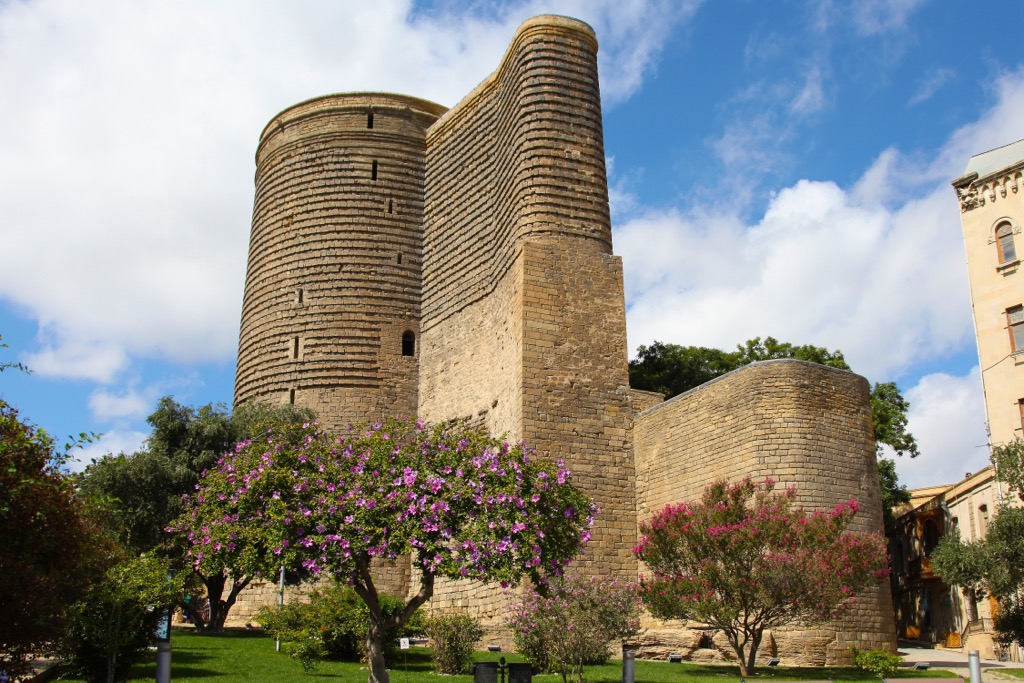
Apart from being a beacon for the lost travellers, the purpose of the tower is still a mystery. There are quite a lot of assumptions, here are just a few of them. It may be part of the fortress wall, an observatory, a cult building of fire worshippers. Scientists believe that in ancient times, the Caspian Sea splashed at the foot of the Maiden Tower.
Anyway, the Maiden Tower is one of the most ancient edifices in the republic. It is included in the UNESCO World Heritage List. Nowadays there is a museum there. If you climb to the top, you will get to the observation deck, where you can admire a great view of Baku. Around the tower there are many caravanserais, stone palaces - the so-called ancient hotels. Merchants from distant countries arriving in Baku during their travels along the Great Silk Road stayed in these very hotels in the Middle Ages.
Many valuable artefacts were found during the excavations of Icheri-Sheher. They are kept in a museum located in the Shirvanshahs' Palace. The museum also exhibits a mysterious collection called the Bail Stones - the silent witnesses of the ancient Sabail Castle or Baku Atlantis, as it was later called. Sabail Castle was a fortress built in the 1230s on a small island in the bay and was intended to protect Baku from the sea, but the wicked Caspian Sea had other plans and the castle went under water soon after it was finished. A miniature model of the fortress can be seen in the Museum of Miniature Books. In this unique museum, there are about 7,500 minute books. Some of them are so small books that they come with a magnifying glass. The museum is listed in the Guinness Book of Records.
The cultural life of Baku is not limited to visiting museums and theatres only. The city has a vibrant community and hosts world competitions, shows and festivals. Every year the city hosts Formula 1, which gathers the fans of high-speed cars. It was Baku that hosted the 57th Eurovision Song Contest, for which a huge Crystal Hall was built.
Azerbaijan enjoys good transport accessibility. You can get to the country by train, plane, bus or even by car. The most convenient and fastest way is surely by plane. Flights to Baku are available from many cities, e.g. Moscow, Istanbul, Mineralnye Vody and others. The country has five international airports: Heydar Aliev, Gabala, Ganja, Lankaran and Nakhchivan. The capital's Heydar Aliev Airport is the biggest in the country.

You can get around the country by plane, train, shuttle bus or coach, taxi, or by car. By the way, taxis here are not the usual yellow colour, but purple, for which they are called ‘little eggplants’.
While in Azerbaijan, you should pay attention to some points:
In general, tourism and entertainment are actively developing in modern Azerbaijan, which at the same time is focusing on maintaining its centuries-long traditions. Enjoy your visit to this wonderful country!
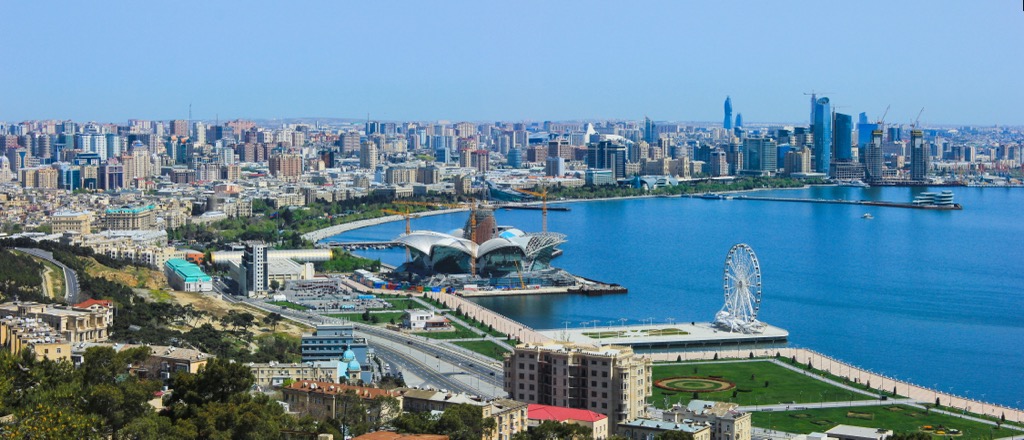
Explore Azerbaijan with the PeakVisor 3D Map and identify its summits.








top50
ultra
russia-ultras
azerbaijan-ultras
top50
ultra
russia-ultras
azerbaijan-ultras
